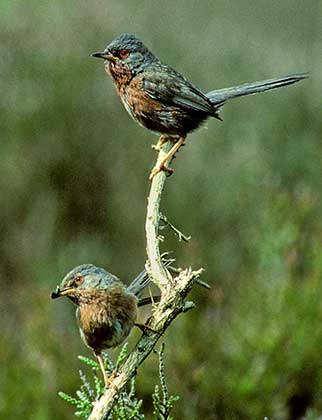Dartford warbler (Sylvia undata)
When: All year round
How many: Numbers vary, but the population in recent years has been relatively high – around 440 pairs in 2006, for example.

Dartford warblers are tiny creatures. No more than 12.5 centimetres (5") long, half of that is taken up by a tail habitually held cocked at a jaunty 45 degree angle. Indeed, body size is not much bigger than that of a wren, which qualifies the Dartford warbler as one of Britain’s smallest birds.
Normally shy and secretive birds, that long tail and short, quite broad wings aid manoeuverability in the depths of gorse or heather clump. Indeed, Dartford warblers are habitual skulkers in the undergrowth, and can be incredibly difficult to see – presence is often betrayed only by their occasional forays out into the open, and harsh, churring calls.
Early in the morning, though, particularly on bright spring days, Dartford warblers are likely to be tempted out to sing their scratchy, warbling song, and perform extravagant dancing, whitethroat-like display flights. From atop a sprig of gorse, males lift into the air on short, fluttering wings, spiralling upwards, all the time singing, before dropping down to land on the same or an adjacent perch.
But mostly, Dartford warbler flight is weak as they travel short distances at low level, skimming across the tops of the heather.
Both sexes are subtly coloured, with wine-red under-parts, and lots of brown and grey above, which helps them blend beautifully with the reddy-coloured heather stems. Male Dartford warblers, however, are a little more boldly marked than females, and have pale spots around the chin.
Although very much at the northern edge of their European range, in days gone by, when their favoured heathland habitat was a much more common feature of the countryside, Dartford warblers were relatively widespread across southern England, with stragglers reaching as far north as Shropshire and Staffordshire. And not surprisingly, they were first noticed and named in the area around Dartford, Kent.
Nowadays, though, particularly after harsh winters, distribution is largely restricted to the few remaining areas of southern heathland. In fact, at times the New Forest regularly holds 75%, or more, of the national Dartford warbler population.
And the significance of harsh winters? Well, unusually for a bird that feeds wholly on spiders, insects and other similar invertebrates, Dartford warblers are largely sedentary, not normally travelling far from their natal area other than during post-breeding season, relatively short-range dispersals.
This stay at home habit, together with small size, makes Dartford warblers very susceptible to bad weather, particularly when snow blankets the heaths. Indeed, at the end of the 19th century, when the Thames famously froze over, Dartford warblers were thought to be virtually extinct in Britain. They were again badly hit by freezing conditions in 1947 and 1979, whilst after the particularly brutal 1963 winter, the New Forest Dartford warbler population fell to around 6 pairs, and there were not many more nationally, making the Dartford warbler at that time one of Britain’s scarcest birds.
But following a succession of relatively mild winters, by 1999 numbers in the New Forest were close to 650 pairs, although a survey in 2006 found only an estimated 440 territorial males, and the hard winter weather of 2009/2010 almost certainly further affected numbers. Nevertheless, these delightful birds can still be seen on many of the New Forest heaths where there is a combination of gorse to hunt through, and heather for nesting.
References:
The Birds of the Western Palearctic: Stanley Cramp, et al.
The Historical Atlas of Breeding Birds in Britain and Ireland, 1875-1900: Simon Holloway
Hampshire Bird Reports: Hampshire Ornithological Society
The New Forest – A Natural History: Colin R. Tubbs
More links
Other related links
Search this site

Sadly, 58 animals were killed - 35 ponies, 13 cows, 8 donkeys and 2 sheep, whilst a further 32 were injured - 3 pigs, 9 donkeys, 11 cows and 9 ponies.
(Forty-three accidents occurred in daylight, 15 at twilight and 101 in the dark. Twenty-seven accidents were not reported by the driver involved).
Here's just one horrific example - Three donkeys killed in collision with van at notorious New Forest blackspot (Advertiser and Times)

